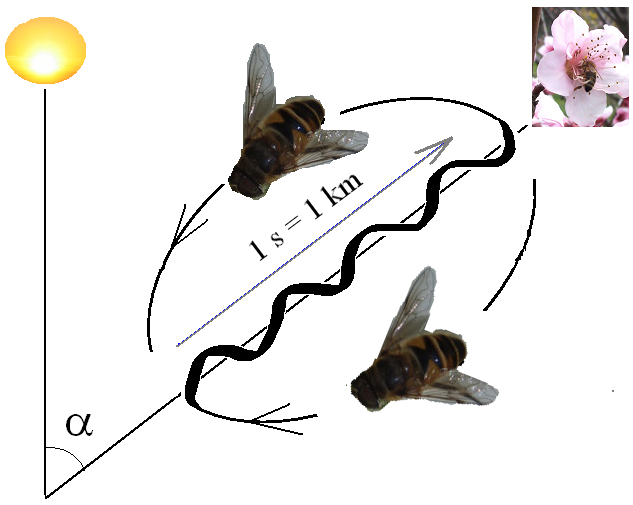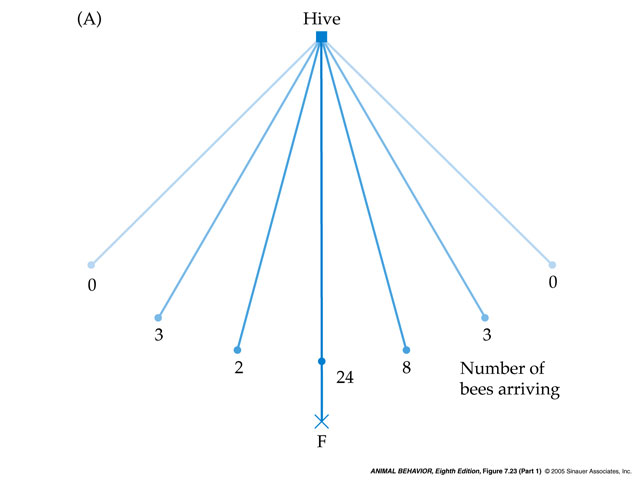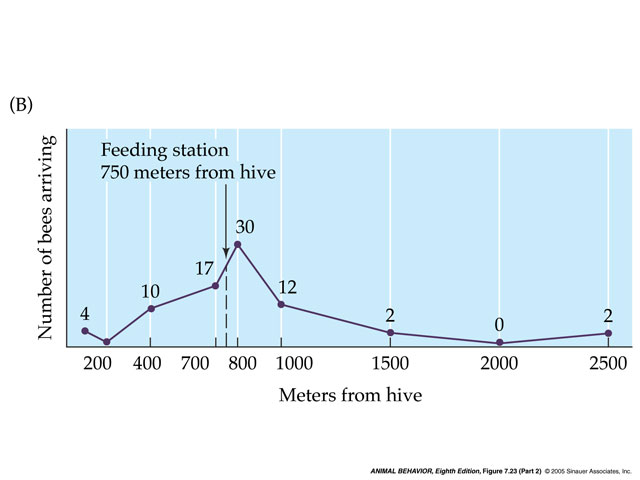Dance Bee Dance
Biology 342 Fall 06 A. Mahan
| Home | Phylogeny | Ontogeny | Mechanism | Adaptive Value | References | Course Home |
Mechanism
Specific elements of dances communicate distance and direction information.
Dances of Apis mellifera occur on the vertical surfaces of the dark hive, so hivemates must feel the motions of the dancing forager. The waggle of the dance, which occurs only when the distance to food is more than 20 meters from the hive, is done at an angle that describes the direction of the source. If the waggle is done in a directly vertical direction, the food is in the direction of the sun at that moment (Alcock 2005). If the waggle is done directly down, the source is in the opposite direction of the sun. In the image below, the angle (alpha) represents the direction of the food source in relation to the sun, and the dancer is incorporating this angle into the waggle of her dance (Image: Adriusa).
The dancing bee can also convey distance information to her hivemates, either by the duration of the dance or by the number of dance revolutions she makes in a set time period (Alcock 2005). If the distance to a food source is less than 20 meters from the hive, a round dance will be performed without a waggle component. If the food source is between 20 and 80 meters away, foragers may use either the round or the waggle dance, and if the source is more than 80 meters away, foragers will use the waggle dance exclusively (Tautz 2003).
In the 1960's, von Frisch investigated how bees respond to the dances of their hivemates in order to establish that they are able to communicate both distance and direction information. When a forager discovered a food source (labeled F in the image below), she returned to the hive and performed a waggle dance. The direction that each hivemates traveled after observing the dance was recorded and the results are shown in the diagram (Image: Alcock Figure 7.23A).
The diagram shows clearly that a significant majority of the bees flew in the direction of the food source. This observation shows that bees are able to take in information about the direction of a food source from a hivemate's dance. Once it was established that bees can communicate the direction of a food source, von Frisch investigated whether bees can also communicate distance information.
The image to the right describes the results of an experiment in which the distance that bees traveled after observing a waggle dance was recorded (Image: Alcock Figure 7.23B). Just as directional information was clearly obtained by observing the dance, distance information was also accurately transmitted to hivemates. The number of bees that traveled to sites around the food source was recorded and it was shown that most bees traveled the distance at which the original forager discovered food (von Frisch, 1967).
Today, investigators are trying to assess how foragers are able to gauge the location of food accurately in order to pass the information on to hivemates. Work done by DeMarco and Menzel suggest that bees' ability to discern distance information is based on a landmark dependent, visual sense rather than an innate map sense (DeMarco 2005). Experiments that altered the way foragers interpreted landmarks resulted in a subsequent change in the information they transmitted through their dances. This finding provides some insight into how these bees navigate to and from their hives.


